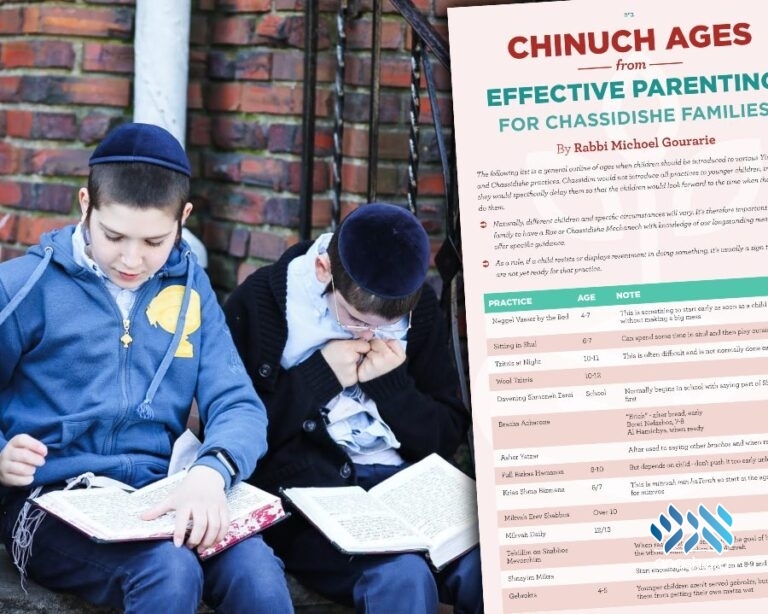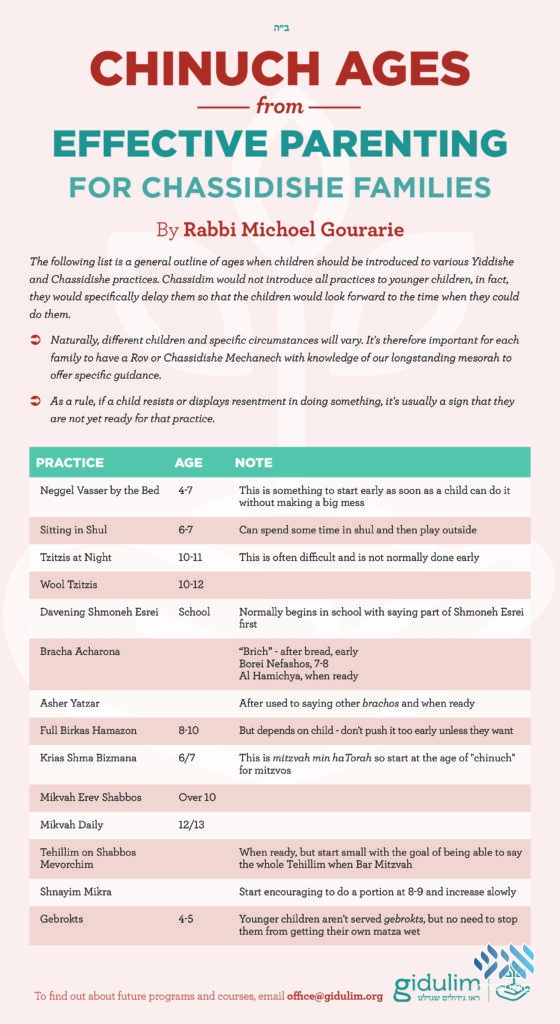At what age should a child say Tehillim on Shabbos Mevorchim? Go to mikvah on Friday? Wear tzitzis at night? This simple chart outlines the right ages so you can set your child up for long-term success.
By Anash.org writer
A common theme in the recent course “Effective Parenting for Chassidishe Families” by Rabbi Michoel Gourarie was the issue of giving children age-appropriate instructions. Starting a child at the right age – not later or earlier, explained Rabbi Gourarie, is vital for lasting success.
Historically, Chassidim would not introduce all practices to younger children. In fact, they would specifically delay them so that the children would look forward to the time when they could do them.
The following list is a general outline of ages when children should be introduced to various Yiddishe and Chassidishe practices. Naturally, different children and specific circumstances will vary. It’s therefore important for each family to have a Rov or Chassidishe Mechanech with knowledge of our longstanding mesorah to offer specific guidance.
As a rule, if a child resists or displays resentment in doing something, it’s usually a sign that they are not yet ready for that practice.
To download a PDF file, click here.
For updates on future programs and parenting courses, email [email protected].


1. Are there any sources for these guidelines?
2. Specifically wondering about what age to enforce waiting 6 hours between meat and milk.
Thank you for your great website.
It should be mentioned that all recommendations are only “suggested”!
E, G. Mikvah for children. If you wait until age 10, they will never going on a regular basis. I believe and we have done this in our family. Our young children start going to the Mikvah only Erev Shabbos Mevorchim (once a month) and gradually increase as they get older.
I know in the article it is mentioned that each family should ask its own Rov or mashpia. All the ages are being presented as the appropriate proper age based on history.
It would be nice if the author put footnotes as to the actual sources.
Thanks
The whole concept of requiring for “sources” for chassidishe way of life is flawed.
Yiddishkeit and Chassidus is a living tradition that was practiced by generations of chassidim. This is a fundamental concept in Yiddishe tradition:
שאל אביך ויגדך זקניך ויאמרו לך.
The Frierdiker Rebbe writes at length about the importance of גדולה שימושה, learning from the conduct of older chassidim.
You need to find someone who knows what that tradition is and follow them. Changing the tradition based on a new theory or source is not the way of chassidim.
The sources that are wanted is from which זקניך this is coming from.
The common גדולה שימושה seems to dictate a lot earlier then what is written on the chart.
So you are correct when saying “You need to find someone who knows what that tradition is and follow them. Changing the tradition based on a new theory or source is not the way of chassidim”
We just want to know what and where this tradition comes from.
Can you please put sources for these ages being there norm?
Or at least what it’s based off?
As you write in the chart “knowledge of our longstanding mesora”, is crucial in these matters.
Therefore they need sources from the Rebbe or at least from chasidim of the previous generation.
Specifically:
1) about tzitzis at night for kids: I am b”h from a very big extended chabad family and everyone I know from family and friends slept with their tzitzis on from the day they put it on – 3. For sure not waiting till 10-11.
The chinuch is that a yid doesn’t take off his tzitzis. Period.
2) on wearing wool tzitzis: also almost everyone I know started before 10-12, most starting even as early as 6.
3) about negel vasser by the bed: is this referring to washing, or preparing it the night before?
If it’s referring to washing, a lot of people I know when woken by their parents were washed negel vaser by the bed from when they were babies.
Again, if the sources of what this is based on would be put up it would be greatly appreciated!
Just because some families do something that doesn’t make it into a “mesorah.”
Changing the Lubavitch tradition – even for the better – has done a lot of damage. As meforshim write that “bal tosif” (adding in mitzvos) leads to “bal tigra” (taking some off). When we can change things based on our own ideas, everything is up for change.
Though here we aren’t talking about mitzvos min haTorah, the concept is true for derech hachassidus as well.
(That’s not the same as someone who has a hergesh to add in something and realizes that its just their own hergesh.)
Can you please put sources for these ages being there norm?
Or at least what it’s based off?
As you write in the chart “knowledge of our longstanding mesora”, is crucial in these matters.
Therefore they need sources from the Rebbe or at least from chasidim of the previous generation.
Specifically:
1) about tzitzis at night for kids: I am b”h from a very big extended chabad family and everyone I know from family and friends slept with their tzitzis on from the day they put it on – 3. For sure not waiting till 10-11. The chinuch is that a yid doesn’t take off his tzitzis. Period.
2) on wearing wool tzitzis: also almost everyone I know started before 10-12, most starting even as early as 6.
3) about negel vasser by the bed: is this referring to washing, or preparing it the night before?
If it’s referring to washing, a lot of people I know when woken by their parents were washed negel vaser by the bed from when they were babies.
Again, if the sources of what this is based on would be put up it would be greatly appreciated!
I 100% agree with Mendel.
We always slept with with a talis koton from our third birthday and bh I am zoche to have taught my kids to do the same.
We also wore wool talis koton by day from age 3 (cotton at night).
It was wool tzitzis day and night from age three for our yingelach. Never occured to us to do otherwise.
There is a major inyan in having negel vasser near the bed, clearly in a sicha from the Rebbe – regardless of the child using it to wash themselves or being washed by their parents.
The Rebbe says that negel vasser near the bed is an open indication the the sleeping child is a yid!
Why leave that till the child is older?
במחילת כבוד הרב
We are living post 5741 when the Rebbe created Tzivos Hashem, the Rebbe wants children to be trained in these things from the youngest ages.
If you are basing on tradition from the past – the Rebbe changed that, and told us a new way which in the Rebbes words is THE ONLY WAY to ensure a child will remain frum, that is to train them from the youngest ages to do what hashem wants.
Just for ex. Tzitzis at night is part of the uniform of Tzivos Hashem from 3 years old, from where do you derive that at night its different?
Of course they must be trained to do what Hashem wants. And Chinuch according to his age is what Hashem wants of him, just as you want tell a child that Hashem wants him to learn all day and not play…
You wont tell a child that Hashem wants him to learn all day, because its simply not true.
Hashem wants a child to play, and his playing should be with ahavas yisroel etc.
היות הגוף בריא מדרכי השם הוא
Wearing Tzitzis at night is what Hashem wants from a child.
We don’t need to make these things up on our own, we have the shulchan aruch and the Rebbeims torah.
They should start saying shnayim mikra at the same time they start saying Borei Nefashos?
“As a rule, if a child resists or displays resentment in doing something, it’s usually a sign that they are not yet ready for that practice.”
Maybe it is being resisted because it isn’t being presented to the child properly? Or maybe something else is bothering the child?
If a 10 year old is not interested in full bentching, are they “not yet ready for that practice”?
My 2 year old knows borei nefashos (t.t.t.o. zol shoin zayn di geula)
Why wait till 7?
What was the criteria for items to make it to this list?
Is this list based on something specific?
Its kinda random, no?
Like gebroks on pesach is included, what about oil menora or when to have their own kaarah, or reviis wine on chol hamoed?
Even daily stuff, saying birchas hashachar before eating, is that before shmone esrei?
I would like to share a personal family mivtza- finishing gantz Tehillim on Shabbos Mevorchim for the very first time earns each einikel in their turn a leather-bound medium sized Tehillim with their name embossed in gold.
Each time I get a call telling to get my money ready because someone is very close to the finish line, the excitement is high. The ages vary – each one according to his or her abilities, and it ingrains in their souls how holy and special we are and what a special zchus The Aibishter gave us by choosing us to be Lubavitcher Chassidim.
MOSHIACH NOW
So here are some of the sources!
Negel vasser should be near the childs bed from before they turn one month.
ספר הזכרונות ח”ב פצ”ג
Shul is not for running around, rather to behave באימה וביראה and keep כבוד בית הכנסת.
Children that run around should not be brought to shul.
שו”ע אדה”ז סי’ קכד ס”י
From 3 years old a child should sleep with his yarmulka.
אג”ק אדמו”ר הריי”צ ח”ח ע’ תקנח
(Wool tzitzis should be started right away when they wear tzitzis)
In reference to chinuch, you start right away with hiddur mitzvah.
תורת מנחם תשמ”ט ח”ד עמ’ 142
(Full Shmone esrei should be started from 6 years old)
From 6 years old a child should be saying מאה ברכות.
שיחת ש”פ חיי שרה תנש”א
Regarding shmone esrei specifically ראה התקשרות גליון תקצד ע’ 15
Saying בריך רחמנא is until age 3, from 3 years old, a child should start getting accustomed to bentching regular ברכת המזון.
שיחת ט”ו בשבט תשל”ז
וראה התקשרות גליון תקצד ע’ 15
you thanks mendel for the valid points, I myself wore Wool Tzitzis at night and had Negel Vaaser for as small as I can remember & BH I grew up %100 okay! it looks like the whole point of this article is saying to push off and not to do early, but here I see that stuff my parents always did from when we were very young, has a opposite effect stated in the article, I always wanted it more and couldn’t imagine life without it!
To all those questioning, it should be noted that this was discussed and explained by Rabbi Gourarie in the chinuch course he gave. There he explained at length the idea behind it and how it should be applied.
I don’t think he meant it to be hard rules. It’s just meant to give an idea of when most children are ready so that the chinuch is done properly.
What’s comical is when you see some parents who are very into making sure their children do all the chassidishe things but they themselves aren’t so careful with covering all their hair, davening with a minyan, etc.